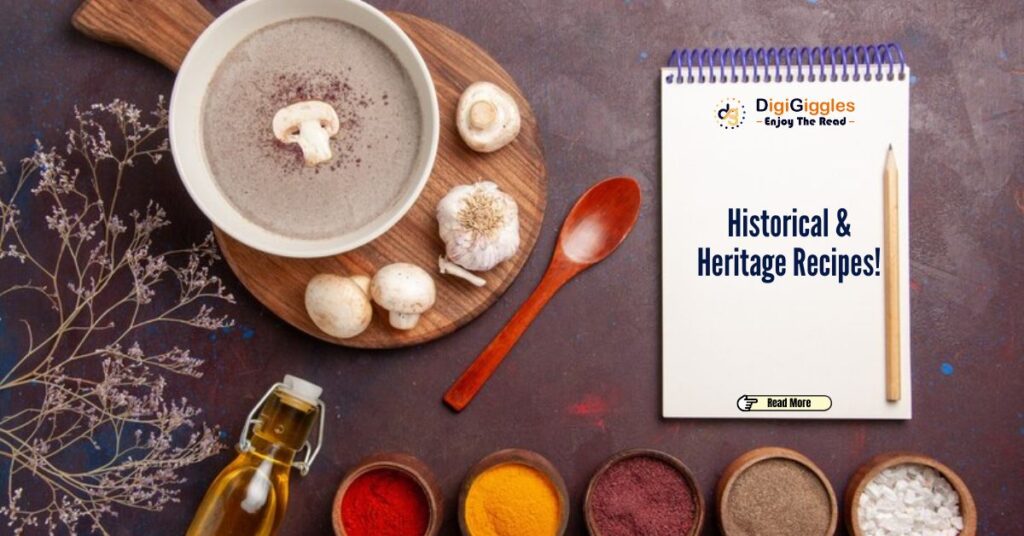
India, a land of vibrant cultures, diverse traditions, and rich history, is also home to a culinary heritage that spans millennia. From the ancient Vedic times to the Mughal era and beyond, each period has left its mark on the country’s cuisine, resulting in a tapestry of flavours, aromas, and cooking techniques that are uniquely Indian. Step into the culinary time machine as we embark on a delectable journey through the pages of India’s gastronomic history.
The land of spices and flavours, where every dish tells a story, and every recipe is a slice of heritage. Today, we dust off the pages of forgotten cookbooks and uncover the treasures of yesteryears. Join us as we don our aprons and whisk ourselves back in time to savour the rich tapestry of India’s historical and heritage recipes. Get ready for a blend of spice, nostalgia, and a generous pinch of humour – because in the world of culinary time travel, laughter is the best seasoning.
A Flavorful Walk Down Memory Lane
In the heart of India’s culinary heritage lies a spice bazaar that transcends time. From the vibrant bazaars of Old Delhi to the bustling markets of Mumbai, the spice chronicles have been brewing for centuries. Each spice, a storyteller; each dish, a chapter. Let’s unravel the secrets of garam masala, the magic of saffron, and the allure of asafoetida – because, in the world of historical recipes, spices are the unsung heroes.
Remember the aroma that wafted through your grandmother’s kitchen? That’s the scent of tradition, the fragrance of heritage recipes passed down through generations. Whether it’s the soul-satisfying dal makhani simmering on the stove or the aromatic biryani baked to perfection, grandma’s kitchen diaries are a treasure trove of culinary wisdom. These recipes are not just about ingredients; they’re about the love infused into every stir, every knead, and every simmer.
A Culinary Journey Through the Ages
Vedic Cuisine
The earliest traces of Indian cuisine can be found in the Vedic scriptures, dating back to around 1500 BCE. These texts provide insights into the dietary habits of the ancient Indians, who consumed a predominantly vegetarian diet based on grains, legumes, fruits, and vegetables. Dairy products and ghee played a significant role in Vedic cuisine, while spices were used for their medicinal and flavor-enhancing properties.
The Mughlai Majesty
The Mughal era, spanning from the 16th to the 19th centuries, brought a significant transformation to Indian cuisine. The Mughals, with their Persian and Central Asian influences, introduced new ingredients, cooking techniques, and culinary traditions to India. This fusion resulted in a rich and elaborate cuisine characterized by the use of aromatic spices, dried fruits, and nuts, along with a sophisticated presentation and a focus on savory flavors. As we delve deeper into India’s historical recipes, we find ourselves in the royal courts of the Mughals. The Mughlai Majesty, a culinary spectacle of kebabs, kormas, and aromatic pilafs. Each dish fit for a king – or a foodie with a penchant for regal flavors. The biryanis, the niharis, and the decadent Shahi Tukda – a feast that transcends time and tantalizes taste buds.
A Culinary Tapestry
Over the centuries, Indian cuisine has evolved into a diverse tapestry of regional specialties, each with its unique flavors, ingredients, and cooking methods. This diversity is a testament to the vastness of the country and the influence of various cultures and traditions. From the fiery Vindaloo of Goa to the delicate biryani of Lucknow, the hearty thali of Gujarat to the tangy tamarind-based dishes of South India, each region boasts its culinary gems that reflect its unique heritage.
Preserving the Culinary Legacy
Heritage recipes, passed down from generation to generation, are the cornerstones of Indian cuisine. These recipes embody the culinary wisdom and traditions of the past, preserving the essence of authentic Indian flavors and cooking techniques. From grandmother’s secret spice blend to the festive delicacies prepared during special occasions, heritage recipes connect us to our culinary heritage and provide a glimpse into the lives of our ancestors.
Honoring Culinary Traditions
In today’s fast-paced world, it is more important than ever to preserve and honor our culinary heritage. Heritage recipes are not just about food; they are about preserving traditions, connecting with our roots, and celebrating the rich tapestry of Indian cuisine. By sharing these recipes, we ensure that their cultural significance lives on, inspiring future generations to appreciate and carry forward the legacy of Indian gastronomy.
Conclusion
Indian cuisine, with its rich history, diverse flavors, and enduring traditions, is a testament to the country’s cultural heritage. By exploring historical and heritage recipes, we embark on a culinary journey through time, savoring the culinary legacy of our ancestors and gaining a deeper appreciation for the intricate flavors and traditions that make Indian cuisine truly unique. Let us continue to cherish and preserve these culinary gems, ensuring that the legacy of Indian gastronomy continues to thrive for generations to come.
As our culinary time travel adventure draws to a close, let’s savor the flavors of India’s historical and heritage recipes with a hearty laugh and a contented palate. In the world of spices and stories, each recipe is a chapter, and each bite is a page turned. So, here’s to the culinary time travelers, the seekers of flavor, and the keepers of tradition. May your kitchens be filled with laughter, your pots bubble with nostalgia, and your plates overflow with the richness of India’s gastronomic legacy. Happy cooking – where every recipe is a step back in time and a leap forward in flavor!